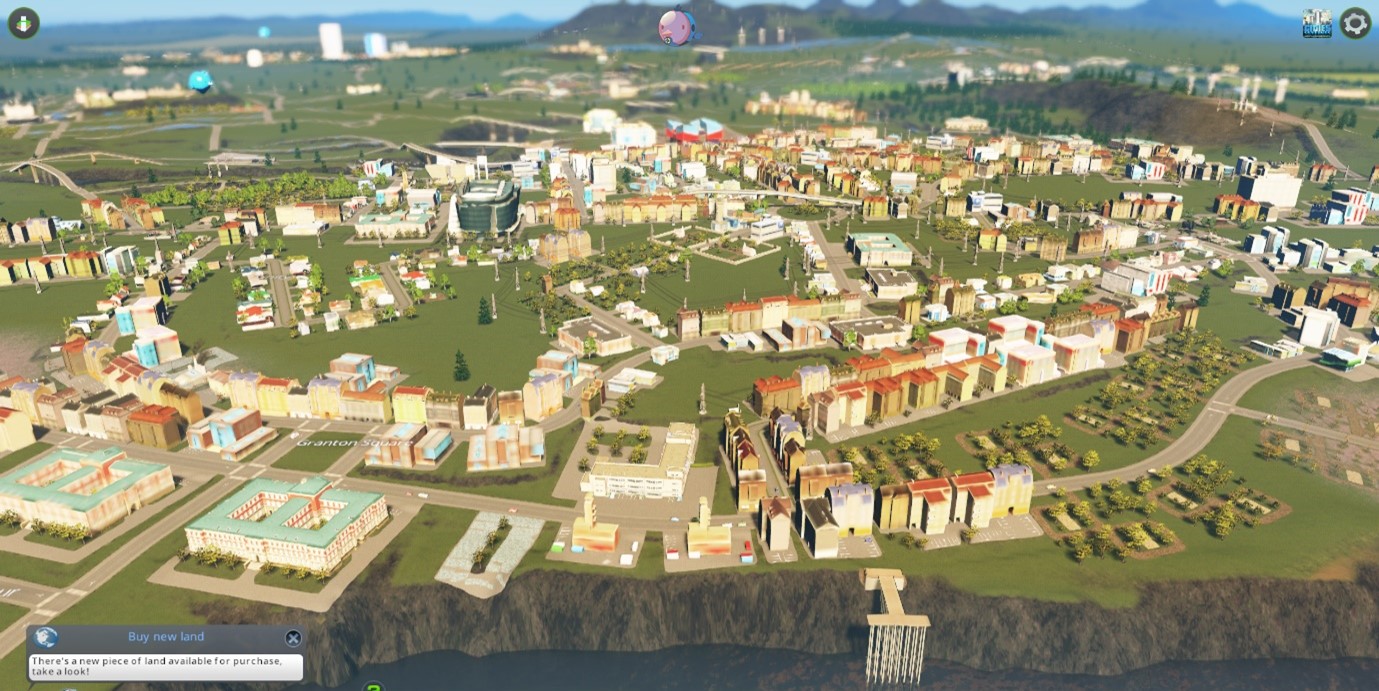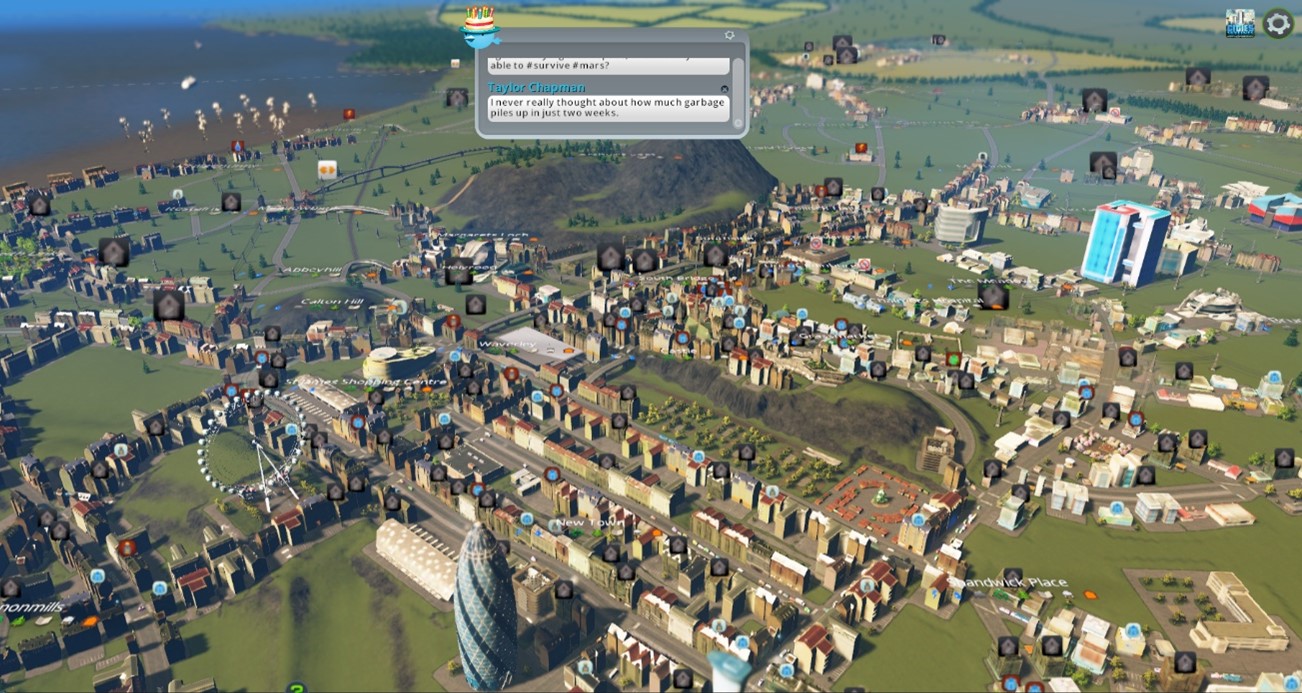Last week, we reported on an exciting project APiC co-led with Sustrans Scotland, using the game Cities: Skylines to explore urban design with pupils at Tynecastle High School in Edinburgh. We discovered a wide range of uses for Cities Skylines in the classroom, which you can read about in part 1 of this series. All work in this project relates to exploring the 20 minute neighbourhood concept, where the key idea is that all a person’s day-to-day needs can be fulfilled within a 10-minute walk of where they live. This also links with a live project in Gorgie/Dalry.
In this week’s follow-up blog, we explore the insights we gathered by working with young people on this project. Some of these relate directly to planning and design of their local area, while some relate to the City of Edinburgh as a whole.
Different Approaches to Urban Design
The flexibility of Cities: Skylines enabled pupils to follow their own path in city planning and design, and trial what they were most interested in. Below are a few types of approaches we noticed most amongst the pupils:
- Taking a very strategic approach to think about the different neighbourhoods, their needs, and how they might grow in the long term. This parallels how a town planner may act in the real world.
- Focusing more on landmarks, buildings and economic strategy to bring tourists to their city and make it an exciting place to be and visit. This parallels how an architect may act in the real world.
- Ensuring utilities and transport infrastructure is fit for purpose and running smoothly at all times. This parallels the focus of civil engineers and transport planners in the real world.
- Considering how spaces fit together and can be connected by high quality parks, green space and landscaping. This parallels how a landscape architect may act in the real world.
- Attending to the needs and demands of the people. This parallels the focus of a politician in the real world.
It was also clear that the young people were responding to the needs they had previously identified for their local area, as well as their prior learnings in Geography classes on what urban areas need to thrive. The remainder of this blog shows some examples of the pupils work, and the ‘pitches’ they wrote at the end to tell the world about the city they’d created and why you should move there.
A Well-Provisioned Edinburgh
In this interpretation of the city, development is focused mostly in the city centre, and the pupils focused on ensuring ‘Our Edinburgh’ would be a place that would work for all residents:
‘There are a lot of reasons why people should move to our Edinburgh. It’s a very nice city and community. There are a lot of services, so it’s quite safe and has a low crime rate. It’s very clean and there is quite a bit of transport to go around Edinburgh easily. There are also lots of jobs where you could get employed’

Figure 1 An aerial view of Edinburgh City Centre with the rough location of neighbourhoods labelled. Game © Paradox Interactive AB www.paradoxplaza.com
In another version, one pupil built their neighbourhoods in the Sighthill and Gorgie / Dalry areas. They took a stronger focus on ensuring suburban areas of the city are well-provisioned with education and leisure opportunities, which meet people’s everyday needs:
‘You should move to my city because of the amount of jobs available and the big amount of transport like buses, taxis and trains. My city is more focused on the community with lots of educational places like universities, high schools, and also lots of healthcare. I upgraded the roads so there’s more housing and it’s connected to the stops. I also built parks and basketball courts so people enjoy themselves, and shops so people have places to buy things’

Figure 2 Looking from Gorgie towards Haymarket. Game © Paradox Interactive AB www.paradoxplaza.com

Figure 3 An aerial view of the Sighthill area of the City. Game © Paradox Interactive AB www.paradoxplaza.com
Walkable Neighbourhoods
One pupil focused specifically on the Gorgie / Dalry neighbourhood close to their school, drawing strongly on the previous activities where pupils noted what could be improved. This is a well-planned and provisioned neighbourhood, where the location and range of facilities ensures no one needs to leave the local area for day-to-day needs:
‘In Gorgie / Dalry, I built:
A mix of high density and low density houses so we have all the types to meet people’s needs;
A variety of shops near the houses, in walking distance;
Parks all around the area for leisure time and the prominence of greenery;
Schools in the middle of the area and around residential areas to make them accessible.
Hospitals all around the area to deal with medical emergencies
Bus stations nearby for better connectivity; and
Police and Fire stations for the security and safety of people.’

Figure 4 A view from Gorgie looking towards Haymarket. Game © Paradox Interactive AB www.paradoxplaza.com
Another pair focused on similar themes, but also drew out needs around clean energy and benefits of working on a smaller scale:
‘Our city had very good services such as electricity, water supply and natural energy supply. Our city was built in the suburbs and was not that big. In this city there was a decent amount of activities such as tennis, shopping, and swimming. In our city we has a shopping mall and we made a very friendly environment like we added some football grounds, bouncy castles and tennis courts’.

Figure 5 a low density and friendly suburb of Edinburgh, provisioned entirely by clean wind energy. Game © Paradox Interactive AB www.paradoxplaza.com
A Network of Neighbourhoods
One pair took a more regional view in their planning and design, to focus on building up several parts of the city as 20-minute neighbourhoods, and then managing the way they merge:
‘We built in Dalry, Gorgie, Balgreen, the New Town and the Royal Mile. We:
Upgraded all roads to include cycle lanes and trees;
Built each area as its own thing and growing them separately with them eventually coming together;
Built an expensive public transport system with each part of town fully connected via taxi, bus, metro and tram.
Made sure to attend to each part of the town’s needs by assuring services, business, and education are all easily accessible within that individual part of the city’.

Figure 6 Upgraded roads with cycle lanes, trees, and trams. Game © Paradox Interactive AB www.paradoxplaza.com

Figure 7 A view of Gorgie looking south from Murrayfield. Game © Paradox Interactive AB www.paradoxplaza.com
Another pupil chose to build their walkable neighbourhood in the Craigleith area, moving North towards Granton:
‘I built in Craigleith and around the Western General Hospital:
There are plenty of leisure activities;
Plenty of homes to choose from;
Easy access for train, bus and car;
Become part of our 25,000 population!
Plenty of emergency services to keep you safe;
Plenty of schools, ranging from primary schools to university;
If you love nature there are plenty of parks in the city;
A low amount of air and noise pollution keeps the air clean’

Figure 8 A view east from Stockbridge towards Craigleith. Game © Paradox Interactive AB www.paradoxplaza.com

Figure 9 A view south from the Granton Harbour area. Game © Paradox Interactive AB www.paradoxplaza.com
A City for Innovation and Tourism
One group was especially interested in bringing more landmarks and innovation to their version of Edinburgh. They grew their city quickly, and thought about how they could compete with other cities in the region for tourism and highly skilled workers:
‘Our city has many tourist attracts, such as the Gherkin! With a bustling population of over 43,000, and plenty of amenities, you’ll be sure to find everything you need in just a 20-minute walk! Reliable electricity and water supplies, you can be sure you’ll be taken care of, not to mention the hundreds of hospitals, educational facilities, and housing. We are pioneers in the space industry, launching a rocket just last week. Welcome to Edinburgh – we hope you enjoy your stay!’

Figure 10 A view of Edinburgh City Centre, looking South East from Stockbridge, reimagined with new landmarks. Game © Paradox Interactive AB www.paradoxplaza.com

Figure 11 Edinburgh’s pioneering new space programme, built in the Southern outskirts.
Principles of a 20-minute Neighbourhood
Working on city designs using Cities: Skylines proved to be an effective way to take the principles of a 20-minute neighbourhood from paper and into a real-life simulation. The pupils ran with the idea of a 20-minute neighbourhood to show how they would make their neighbourhoods and cities better if they had the chance. The approaches they took show the wide range of ways people’s needs might be met. A particularly strong focus for the young people was a need to tackle air pollution and produce green electricity for their cities. A focus on ensuring core services and wellbeing needs are met was also clear, especially regarding leisure and green space.
This project provided a range of ways to think about city planning, design, and 20-minute neighbourhoods with teenagers. Bringing principles to life is a core benefit of working in this way and responding to the pupil’s lived experience enriched the discussion and practical applications for their ideas. We look forward to seeing how Cities: Skylines may be used in future applications, especially when integrated with live schemes where young people can have true influence.
If you would like to play with the Edinburgh base map we created for the project, you can download it to your version of Cities: Skylines here.
